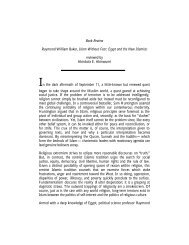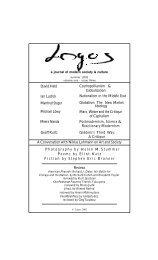Michael J. Thompson Stephen Eric Bronner Wadood Hamad - Logos
Michael J. Thompson Stephen Eric Bronner Wadood Hamad - Logos
Michael J. Thompson Stephen Eric Bronner Wadood Hamad - Logos
You also want an ePaper? Increase the reach of your titles
YUMPU automatically turns print PDFs into web optimized ePapers that Google loves.
Stanley Aronowitz<br />
against the concentrated power of money, it must in some way create its own<br />
political force . . . the left would create an independent labor party” based on<br />
labor’s formidable economic strength. At the same time, Mills argues, it must<br />
enlarge its own base to include the “underdogs”—few of whom are in the<br />
unions. By underdogs Mills does not mean those at the very bottom. They<br />
are, in his view, too habituated to “submission.” He means the working poor,<br />
the unskilled who were largely left out of the great organizing wave of the<br />
1930s and the war years. And he calls for the organization of elements of the<br />
new middle class and the rapidly growing white collar strata whose potential<br />
power, he argues, will remain unrealized unless they are organized.<br />
One may read the New Men of Power with a number of pairs of eyes. At<br />
minimum it can be read as a stimulating account of the problems and<br />
prospects facing post-World War II American labor. It is descriptively<br />
comprehensive of the state of organized labor and the obstacles which it faced<br />
in this period. If Mills was mistaken to believe that unions would have to<br />
become an independent political force to meet the elementary economic<br />
demands of their memberships, it may be argued that this limitation applies<br />
only to the first three decades after the war. Unions did deliver, and in some<br />
cases handsomely, to a substantial minority of the American working class.<br />
They organized neither the “underdogs” nor the new middle class and white<br />
collar clerical, technical and professional workers who were all but ignored by<br />
the postwar labor movement, but forged a new social compact with large<br />
employers for their own members. For a third of the labor force in unions,<br />
and a much larger percentage of industrial workers, they succeeded in<br />
negotiating what may be called a “private” welfare state, huge advances in their<br />
members’ standard of living and a high degree of job security and individual<br />
protection against arbitrary discharge and other forms of discipline.<br />
Ironically, this book is far more accurate in its central prognostication of<br />
labor’s decline for the years since 1973. Labor has paid a steep price for its<br />
refusal to heed Mills’s admonition to forge its own power bloc. Buffeted by<br />
economic globalization, corporate mergers and the deindustrialization of vast<br />
areas of the northeast and midwest and by the growth of the largely non-union<br />
south as the industrial investment of choice, many unions have despaired of<br />
making new gains and are hanging on to their declining memberships for dear<br />
life. Labor is, perhaps irreversibly, on the defensive. In this period, union<br />
<strong>Logos</strong> 2.3 – Summer 2003




